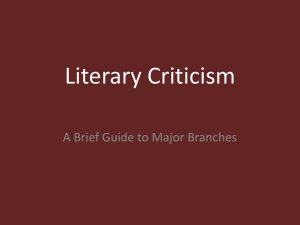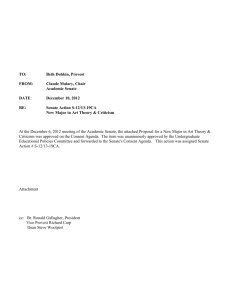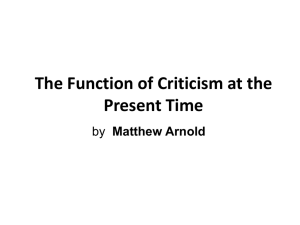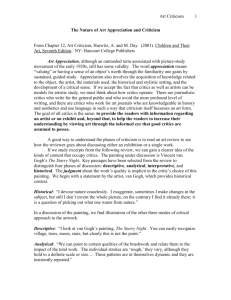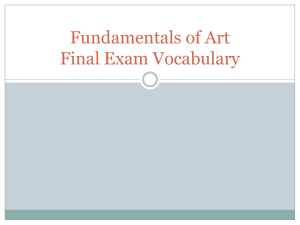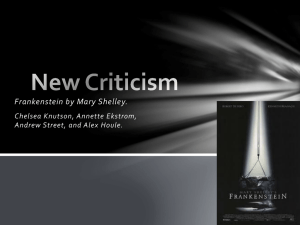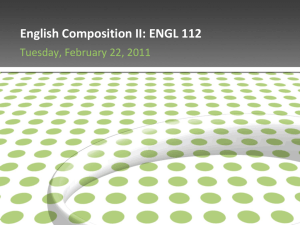Chapter 2-How Should We Look At Art
advertisement
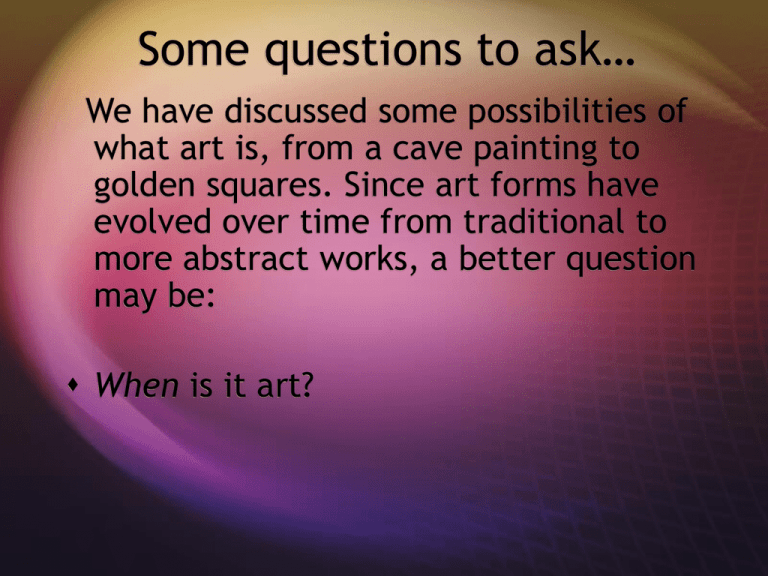
Some questions to ask… We have discussed some possibilities of what art is, from a cave painting to golden squares. Since art forms have evolved over time from traditional to more abstract works, a better question may be: When is it art? Some questions to ask… Under what circumstances do things like stuffed goats or ceramic briefcases become art? What is required for anything to be classified as art? Philosophy of Art The study of art that involves asking and answering all kinds of questions about art Philosophers of art are interested in more than what art is… They want to know: How can art be evaluated? How do people respond to art? How does art relate to our lives & societies? Asking good questions is often more important than finding the answer, as there are multiple answers to philosophical questions. Some questions cannot be answered at all, but the process of searching for answers leads to creative thinking. Now back to one of our original questions: When is an object considered art? What do artworks have in common? Since materials and forms vary so greatly, we cannot determine if a work is art based on these things alone. Think back to the art quiz objects in chapter 1…What do these objects have in common that make them art? Design Good design, a logical & harmonious relationship among all parts of an artwork, is important to consider. Design is the plan the artist uses to organize the art elements (line, shape, form, space, color, value, texture) in a work of art to achieve a unified composition. The opposite of good design is chaos. But what about objects that are not artworks that have good design, such as a real briefcase? Is it possible to determine whether an object is art, strictly based on its materials, form or design? Why? The Aesthetic Experience The theory of perceiving and enjoying something for its beauty and pleasurable qualities. This is what tries to categorize & explain our responses to art forms. Is viewing an artwork the only way to have an aesthetic experience? On the other hand, is it possible to tell if something is not an artwork because it does not give you an aesthetic experience? Intentions and Art Philosophers agree that human intention is necessary in determining when something is art. But who is qualified to do the intending? The Art World Art varies in its forms from ancient cave paintings to traditional landscape paintings. We have no trouble determining these things are works of art. The Art World Useful objects and experimental forms raise questions. In the final analysis, there is no scientific method for determining when something is art. The Art World Good Design The Aesthetic Experience and Human Intention Are important in determining when something is art. But ultimately… The Art World …it’s a matter of judgment. Who makes the judgments? The Art World PEOPLE: artists, dealers, collectors, art critics, museum directors and art teachers These people make up the ART WORLD The Art World Not only are they involved in the production of art, but also selling it, collecting it, displaying it, writing about it and teaching it. Their training, experience and commitment give them the authority to make judgments. The Art World Do these people ever make bad judgments? Sometimes, yes. Some of these experts are called art critics. Criticism & Critics What comes to your mind when you think of criticism? Are they positive thoughts or negative? Criticism & Critics Criticism is simply a discussion of the characteristics of something, be it positive or negative. Art criticism is a systematic discussion of an artwork involving four steps: 1) Description, 2) Analysis, 3)Interpretation and 4) Judgment Professional Criticism These can be found in newspapers, magazines, on radio, television and the Internet. A criticism is also a review. Professional critics get paid to write these reviews. Reviews help consumers decide on whether or not they want to spend time or money on the product being reviewed, since they give a better basis than an advertisement or someone’s opinion. Good criticism also educates us and challenges our tastes. Nonprofessional Art Criticism If pros are getting paid to criticize artworks, why should we do it? Nonprofessional Art Criticism It’s good training and helps you learn about the field of art. Doing your own criticism engages you in making selections, discovering new things in both familiar and unfamiliar works of art, and helps you develop your own taste. Criticism helps you to organize knowledge so you can share it with others. Nonprofessional Art Criticism Artworks, like films, often deal will life issues. Analyzing the information helps you generate ideas for sharing and discussion about your own life. The more you learn about art and the ideas it expresses, the more you learn about yourself and your own ideas and feelings. A Critical Method Description The first step in art criticism where facts about the work are gathered such as objects, people, shapes and colors. It is also important to notate which elements of art are used to express the subject matter. A Critical Method Description It is also important to notate which elements of art are used to express the subject matter. A Critical Method Analysis The second step in art criticism where the relationship among the facts~ the objects, subject matter, elements of art~ is examined. How are the elements organized? It is important to look at the principles of design when the work is analyzed. A Critical Method Analysis Composition refers to the way the elements of art have been organized using the principles of design. When analyzing, we must look at how the artist composed the work. A Critical Method Analysis How are the elements organized? It is important to look at the principles of design when the work is analyzed. A Critical Method Interpretation Explaining the meaning or mood of a work of art. What is it expressing? What is its content? A Critical Method Evaluation Determining the quality or lasting impression of a work of art There is a difference between personal feelings and public value of a work. So what criteria should we use? A Critical Method Evaluation We must look at the design quality. Formalism~ an aesthetic theory that uses the elements of art and principles of design to analyze works of art Expressiveness~ an aesthetic theory that refers to how effectively a work reflects a theme or world view A Critical Method Evaluation Finally, how original is it? Has the idea been expressed in a similar way before? How inventive is the work? Your reasons must stem from the from the information you gathered and analysis you assembled in the first three steps.
